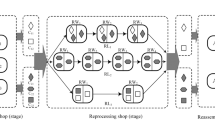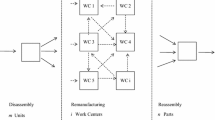Abstract
This study considers the scheduling problem in remanufacturing systems in which end-of-use/life products are separated into their components at a single disassembly workstation, then each component is reprocessed at one of parallel flow-shop-type reprocessing lines, and finally the reprocessed components are reassembled into remanufactured products at parallel reassembly workstations. The problem is to determine the sequence of products to be disassembled at the disassembly workstation, the sequence of components to be reprocessed at each workstation of the reprocessing lines, and the allocation and sequence of the products to be reassembled at each reassembly workstation for a due date-based objective of minimizing the total tardiness. A mathematical programming model is developed to represent the problem, and a priority scheduling approach is proposed for practical applications. To test performances of priority rules, simulation experiments were done on various test instances, and the results are reported. In particular, we show from additional tests that the approach proposed in this study outperforms the previous one that determines reprocessing and reassembly schedules according to the sequence of disassembling products significantly, and also, the rule combination approach that uses different priority rules on disassembly, reprocessing, and reassembly shops outperforms the single rule approach that uses the same rule over the three subsystems.
Similar content being viewed by others
References
Steinhilper R (1998) Remanufacturing: the Ultimate Form of Recycling. Fraunhofer IRB Verlag
Lund RT (1984) Remanufacturing. Technol Rev 87:19–29
Guide VDR Jr (2000) Production planning and control for remanufacturing: industry practice and research needs. J Oper Manag 18:467–483
Sundin E, Bras B (2005) Making functional sales environmentally and economically beneficial through product remanufacturing. J Clean Prod 33:913–925
Lee CY, Cheng TC, Lin BMT (1993) Minimizing the makespan in the 3-machine assembly-type flowshop scheduling problem. Manag Sci 39:616–625
Al-Anzi FS, Allahverdi A (2007) A self-adaptive differential evolution heuristic for two stage assembly scheduling problem to minimize maximum lateness with setup times. Eur J Oper Res 182:80–94
Al-Anzi FS, Allahverdi A (2009) Heuristics for a two-stage assembly flow shop with bicriteria of maximum lateness and makespan. Comput Oper Res 36:2682–2689
Allahverdi A, Al-Anzi FS (2009) The two-stage assembly scheduling problem to minimize total completion time with setup times. Comput Oper Res 36:2740–2747
Shokrollahpour E, Zandieh M, Dorri B (2011) A novel imperialist competitive algorithm for bi-criteria scheduling of the assembly flowshop problem. Int J Prod Res 49:3087–3103
Choi H-S, Kim J-S, Lee D-H (2011) Real-time scheduling for reentrant hybrid flow shops: a decision tree based mechanism and its application to a TFT-LCD line. Expert Syst Appl 38:3514–3521
Chamnanlor C, Sethanan K, Chien C-F, Gen M (2013) Hybrid genetic algorithms for solving reentrant flow-shop scheduling with time windows. Industrial Engineering & Management Systems 12:306–316
Yang J (2015) Hybrid flow shop with parallel machines at the first stage and dedicated machines at the second stage. Industrial Engineering & Management Systems 14:22–31
Linn R, Zhang W (1999) Hybrid flow shop scheduling: a survey. Comput Ind Eng 37:57–61
Guide VDR Jr (1995) A simulation model of drum-buffer-rope for production planning and control at a naval aviation depot. SIMULATION 65:157–168
Guide VDR Jr (1996) Scheduling using drum-buffer-rope in a remanufacturing environment. Int J Prod Res 34:1081–1091
Guide VDR Jr (1997) Scheduling with priority dispatching rules and drum-buffer-rope in a recoverable manufacturing system. Int J Prod Econ 53:101–116
Guide VDR Jr (1997) An evaluation of order release strategies in a remanufacturing environment. Comput Oper Res 24:37–47
Guide VDR Jr, Kraus ME, Srivastava R (1997) Scheduling policies for remanufacturing. Int J Prod Econ 48:187–204
Kim M-G, Yu J-M, Lee D-H (2015) Scheduling algorithms for remanufacturing systems with parallel flow-shop-type reprocessing lines. Int J Prod Res 53:1819–1831
Kizilkaya E, Gupta SM (1998) Material flow control and scheduling in a disassembly environment. Comput Ind Eng 35:93–96
Udomsawat G, Gupta SM (2005) Multi-kanban mechanism for appliance disassembly. Proceedings of the SPIE International Conference on Environmentally Conscious Manufacturing: 30–41
Yu J-M, Kim J-S, Lee D-H (2011) Scheduling algorithms to minimize the total family flow time for job shops with job families. Int J Prod Res 49:6885–6903
Kim J-S, Park J-H, Lee D-H (2016) Iterated greedy algorithms to minimize total family flow time for job shop scheduling with job families and sequence-dependent set-ups. Eng Optim. doi:10.1080/0305215X.2016.1261247
Du J, Leung JYT (1990) Minimizing total tardiness on one processor in NP-hard. Math Oper Res 15:483–495
Baker KR (1974) Introduction to sequencing and scheduling. John Wiley and Sons, New York
Author information
Authors and Affiliations
Corresponding author
Rights and permissions
About this article
Cite this article
Kim, JM., Zhou, YD. & Lee, DH. Priority scheduling to minimize the total tardiness for remanufacturing systems with flow-shop-type reprocessing lines. Int J Adv Manuf Technol 91, 3697–3708 (2017). https://doi.org/10.1007/s00170-017-0057-z
Received:
Accepted:
Published:
Issue Date:
DOI: https://doi.org/10.1007/s00170-017-0057-z




